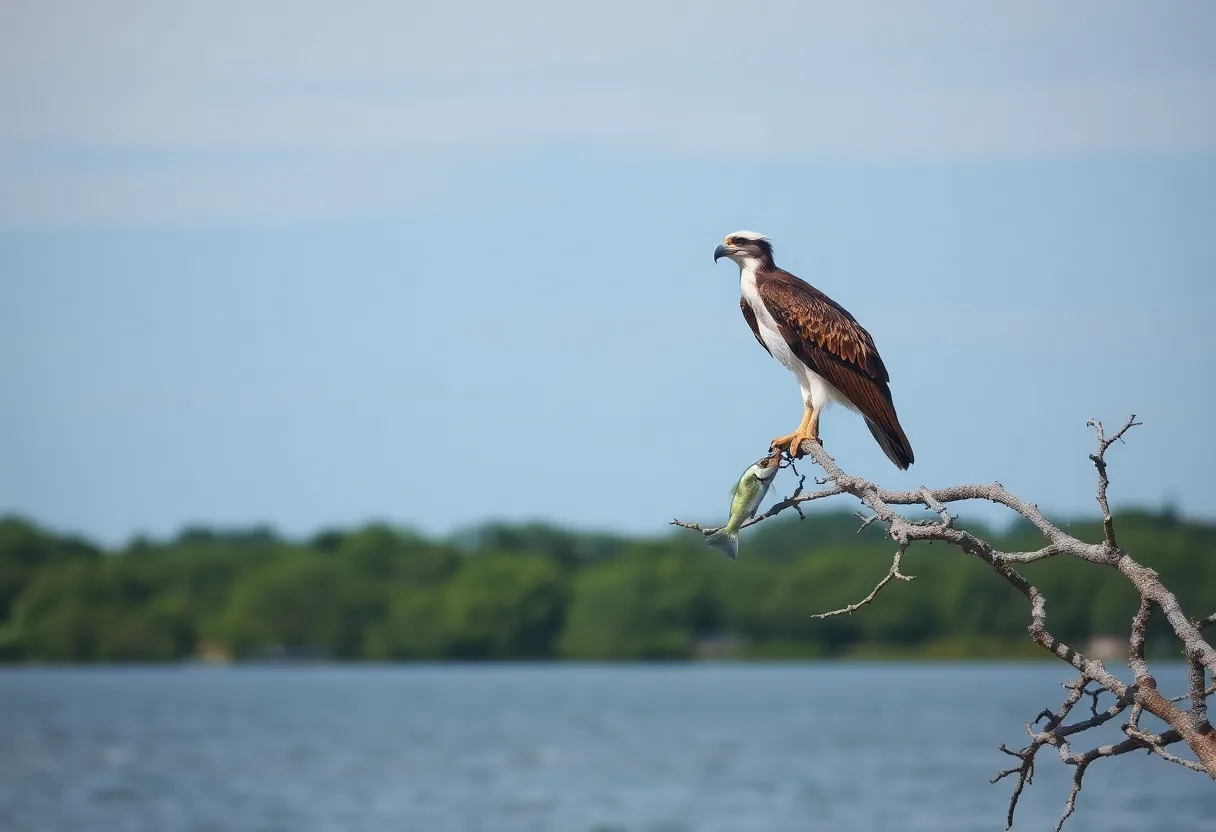News Summary
Recent research highlights a significant decline in the Chesapeake Bay osprey population, driven by reduced menhaden fish availability and new nest predators like minks. Breeding success rates are dropping, threatening the population’s stability. Conservation efforts and fishery management evaluations are underway to address these ecological challenges and protect these vital birds and their habitat.
Gloucester Point, Virginia – Recent findings reveal a troubling decline in the osprey population in the Chesapeake Bay area, primarily linked to a decrease in menhaden fish and the emergence of new nest predators. Research led by Bryan Watts, a professor at The College of William & Mary, highlights the challenges these majestic birds face, including reduced successful breeding evidenced by a failed nest observed on a wooden duck blind in the region.
The failed osprey nest, which was subsequently taken over by diving terns, is part of a growing trend showing difficulties in nesting success for ospreys over recent years. The decline in reproductive success is alarming, as ospreys require an average of 1.15 fledged chicks per year to maintain a stable population. In certain areas, current rates have fallen to less than half this benchmark—raising significant conservation concerns.
The primary driver behind this decline appears to be the significant reduction in available food resources, particularly menhaden, which is a small schooling fish that constitutes a vital part of the osprey diet. Historically, ospreys have rebounded impressively following the ban on the pesticide DDT in 1972, but their resurgence is now being threatened by the dwindling menhaden population. Data indicates that areas experiencing a decline in menhaden also correlate with reduced success in osprey nesting, suggesting a direct impact on their reproductive performance.
Despite these findings, the fishing industry disputes the notion that menhaden fishing is the sole culprit. Industry representatives assert that a combination of factors, including climate change and pollution, may also be contributing to declining osprey populations. Menhaden fishing is of great economic importance, with the industry harvesting over 1.1 billion pounds annually since 1951 for various applications, including fish oil and bait.
Compounding these existing challenges, a new threat has emerged for ospreys in the form of minks. This species has started to raid osprey nests, consuming eggs and chicks—a behavior not previously documented. Researchers are now considering the implementation of protective measures on osprey platforms to counteract the predation by minks and preserve the nests from further declines.
The osprey population health is of growing concern across many regions in the United States, highlighting the urgency for conservation measures. Historical data shows a dramatic increase in osprey populations by six-fold since the 1960s; however, local trends reveal marked declines in certain areas. Current population counts in the Lynnhaven River region, for example, have dropped significantly from a peak of 102 nesting pairs just five years ago.
Conservationists are advocating for a reevaluation of menhaden fishery management practices to ensure the protection of the osprey population moving forward. The Atlantic States Marine Fisheries Commission is considering new management approaches in response to concerns regarding the impact of menhaden fishing on osprey nesting success.
The challenges faced by the osprey population in Virginia are indicative of broader ecological vulnerabilities. The interconnectedness of the fishing industry, avian populations, and environmental changes necessitates a comprehensive approach to wildlife conservation in order to prevent further decline in species that are vital to the ecosystem.
Deeper Dive: News & Info About This Topic
HERE Resources
Decline of Osprey Population in Chesapeake Bay Linked to Menhaden Overfishing
Declining Osprey Fertility Rates Linked to Menhaden Shortage
Declining Osprey Nest Success Linked to Menhaden Shortage
Chesapeake Bay Osprey Population Decline Linked to Menhaden Shortage
Virginia Ospreys Face Decline Due to Menhaden Shortage and New Nesting Threats
Declining Osprey Populations in Virginia’s Chesapeake Bay
Additional Resources
- Los Angeles Times: Osprey Chicks are Dying in Nests
- Wikipedia: Osprey
- MSN: Osprey Came Back from the Brink
- Google Search: Osprey Population Decline
- Tribune Democrat: Osprey Population Concerns
- Google Scholar: Osprey Conservation
- Chesapeake Bay Magazine: Unexpected Nest Robber
- Encyclopedia Britannica: Osprey

Author: STAFF HERE VIRGINIA BEACH WRITER
The VIRGINIA BEACH STAFF WRITER represents the seasoned team at HEREVirginiaBeach.com, your trusted source for actionable local news and information in Virginia Beach, Virginia Beach City, and beyond, delivering "news you can use" with comprehensive coverage of product reviews for personal and business needs, local business directories, politics, real estate trends, neighborhood insights, and state news impacting the region—supported by years of expert reporting and strong community input, including local press releases and business updates, while offering top reporting on high-profile events like the Virginia Beach Neptune Festival, East Coast Surfing Championship, and military homecoming celebrations, alongside key organizations such as the Virginia Aquarium, Virginia Beach Convention Center, and Oceana Naval Air Station, plus leading businesses in tourism and defense like Busch Gardens and Northrop Grumman, and as part of the broader HERE network including HEREWilliamsburg.com, providing credible, in-depth insights into Virginia's vibrant landscape. HERE Virginia Beach HERE Williamsburg





